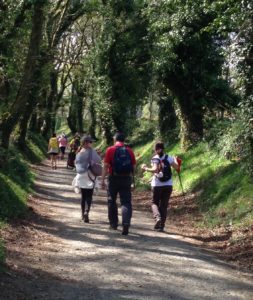If Day 1 of our Camino de Santiago was about getting to the other end, Day 2 was about getting comfortable among the other pilgrims.
It is a diverse group.
Statistics compiled by church officials in Santiago de Compostela, in northwest Spain, suggest half the pilgrims are not Spanish … that Germans are the biggest chunk of foreign pilgrims (at 20 percent, last month), followed by Portuguese (15 percent) Italians (9), Americans (8), the Irish (7), Koreans (4), the French (3) and the rest of the world (34).
So, it is a multicultural group trooping toward the relics of Saint James in Santiago, and you plan accordingly.
English is lingua franca on the trail, but not so much at each end (from the towns where stages start or finish), nor at the little farmhouses and homey eateries en route. Not many Galicians are fluent in English, so it is a good idea to arrive with some Spanish — or odd things may happen to the food order you thought you placed.
English is more common among the pilgrims, who are a fairly young and worldly group. Nearly 40 percent are under 30 and only 10 percent are over 60.
Most all of the peregrinos (Spanish for “pilgrim”) have the same idea — completing the pilgrimage and enjoying the effort of something like 17 miles a day, on average, as well as the scenery of rural Spain.
We already have experienced the acts of kindness often found on the camino, from reports down through the years.
Today, one of our little group was wearing a racer-back tank top as the sun began to heat up the day. A teenage girl asked if we had sun screen. We did not. The girl produced some and the girl’s mother warned of the risk of sunburn during what turned out to be seven hours on the trail, and mom personally slathered sun screen on the back of a person she did not know.
Muchas gracias!
We also have met several townspeople who have gone our of their way to explain how to get to the camino, leading us or giving detailed instructions. (Town residents seem to have a positive impression of pilgrims; they know how difficult the walk is, and they seem to like pilgrims in their little towns.)
A sort of collective bonhomie leads to lots of wishes of “buen camino” — have a good walk.
But not everyone is cheery at all times.
Some bring behaviors to the camino considered improper. Playing music is one. Speaking loudly is another. Blocking a narrow path with your ambling group of four or five or six is yet another.
And then there are just plain unfriendly persons. We asked a scowling peregrino we had seen out on the trail, who (like us) could not find the place where he had reserved a room in Palas de Rei, where he was staying and his non-answer was “buen camino” — which in this case meant “buzz off” (or worse).
(That individual, an adult male of about 55, perhaps represents the fraction of pilgrims whose pilgrimages are three weeks and up, the group that often gets crabby at the younger and more exuberant peregrinos who join the walk for the final five stages. Like we have done. Earlier, we had seen him at a country restaurant, smoking cigarettes and eating alone.)
Other pilgrims have jumped a queue or brought along a dog (which does not work on the trail) or been careless about littering.
Mostly, people are polite and well-mannered, especially when they recall we have similar goals and are all trying to walk some significant distance every day, whether it is three days or five days or 30, and perhaps learning more about ourselves along the way.


0 responses so far ↓
There are no comments yet...Kick things off by filling out the form below.
Leave a Comment